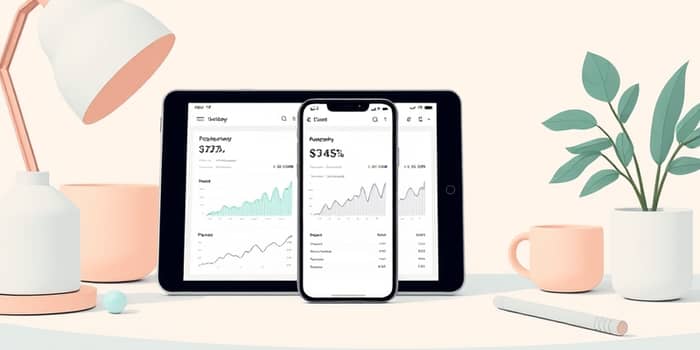In a world saturated with notifications, pop-ups, and endless menus, achieving a state of financial clarity can feel like an uphill battle. With so many features vying for attention, users often struggle to maintain focus on the fundamentals of budgeting: income, expenses, and goals. Adopting a minimalistic interface in your budgeting app can transform this experience into a calm, efficient journey toward financial wellness, freeing you from digital noise and empowering you to make clear, confident decisions about your money.
The Power of Digital Minimalism in Finance
Digital minimalism is more than a design trend—it’s a philosophy that values purpose and simplicity over excess. When applied to budgeting, it helps users avoid clutter and confusion by presenting only the most relevant financial information. Instead of overwhelming charts, stacked menus, or flashy animations, a minimalist design offers a clean dashboard that highlights your balance, spending patterns, and upcoming bills.
By stripping away nonessential elements, a minimalistic interface allows you to focus on what matters most: tracking your money, setting realistic goals, and understanding your financial habits. This approach reduces cognitive load and fosters a sense of calm, so you can budget with intention rather than distraction.
Key Features of Top Minimalistic Budgeting Apps (2025)
Leading budgeting apps in 2025 have embraced minimalism without sacrificing functionality. They serve as benchmarks for an ideal distraction-free environment, each offering unique features that promote clarity and ease of use.
- Quicken Simplifi: A seamless, scrolling landing page reveals balances, net worth, and recent transactions, using playful yet uncomplicated visualizations. Available on web and mobile, it supports joint accounts and nets an intuitive overview in seconds.
- YNAB (You Need A Budget): Built around zero-based budgeting, YNAB assigns every dollar a purpose. Its straightforward interface avoids information overload while offering interactive workshops to deepen user understanding.
- EveryDollar: Focuses on a simple zero-based method with a clean, uncluttered flow. The free version provides the essentials; premium adds automated bank syncing and tracking.
- PocketGuard: Highlights disposable income through its “In My Pocket” feature. Users get a quick read on spendable money, reducing impulse purchases.
- Goodbudget: Employs a digital envelope system displayed visually to promote mindful spending and syncs across devices for household budgeting.
Together, these apps prove that robust financial management need not rely on complex interfaces. By prioritizing core functionalities, they deliver fast-loading, distraction-free tools that keep users engaged and in control.
Data-Driven Comparison of Leading Apps
Understanding how these minimalistic apps stack up can guide your choice. The table below highlights pricing, standout features, and user ratings, demonstrating how simplicity and power can coexist in modern budgeting tools.
This comparison reveals that even within a minimalistic framework, features like real-time sync and collaborative budgeting are readily available, letting you choose an app that balances simplicity with specific needs.
Designing Your Own Distraction-Free Interface
If you’re developing or customizing a budgeting tool, these UX best practices will help you craft a truly minimalistic experience:
- Prioritize essential information on the main view by placing balance summaries and upcoming bills front and center.
- Fast syncing and real-time updates keep data current without visible loading screens or delays.
- Clean visualizations that show data simply use clear bar charts or line graphs instead of overly detailed graphics.
- Implement intuitive navigation with minimal friction—single-scroll dashboards outperform deep menu structures.
By applying these principles, you ensure every tappable element serves a clear purpose, guiding users through budgeting tasks with uninterrupted focus and confidence.
Real-Life Benefits of Minimalistic Budgeting
Empirical studies and user feedback consistently highlight the advantages of streamlined budgeting interfaces. Individuals report reduced anxiety when financial information is presented clearly, leading to more consistent adherence to spending plans and long-term goals.
A distraction-free app reduces decision fatigue, allowing users to allocate energy toward strategic financial choices rather than navigating complex menus. Many note improved mindfulness around daily expenses and a heightened sense of control over their finances.
- Enhanced focus on long-term financial objectives
- Greater consistency in tracking and planning expenses
- Lower cognitive load and reduced burnout
- Accelerated habit formation and goal attainment
These benefits underscore why minimalism is not merely aesthetic; it’s a catalyst for sustainable financial health.
The Future of Distraction-Free Financial Tools
Looking ahead, we foresee minimalistic budgeting apps integrating artificial intelligence to provide personalized insights without compromising simplicity. Imagine predictive spending alerts gently woven into a clean dashboard or automated goal adjustments delivered through subtle notifications.
Moreover, platforms will likely expand collaborative features—couples or families can share minimalistic views of joint budgets, ensuring everyone stays aligned without overwhelming interfaces.
At its core, the evolution of these tools will revolve around one principle: simplify the user journey to empower individuals with clear, actionable financial intelligence.
Minimalism in budgeting is more than an aesthetic choice; it’s a transformative approach that restores clarity, reduces anxiety, and fosters lasting financial wellness. By embracing clean design and focusing on the essentials, you can navigate your financial life with unprecedented ease and confidence.
References
- https://www.nasdaq.com/articles/10-best-budgeting-apps-2025-stay-control-your-finances
- https://www.nerdwallet.com/article/finance/best-budget-apps
- https://www.engadget.com/apps/best-budgeting-apps-120036303.html
- https://www.kiplinger.com/personal-finance/how-to-save-money/best-budgeting-apps
- https://www.spoken.io/blog/the-best-budget-apps
- https://geniusee.com/single-blog/16-techniques-for-creating-a-user-friendly-interface
- https://www.cnet.com/personal-finance/banking/best-budgeting-apps/
- https://www.hellobrio.com/blog/ipad-first










